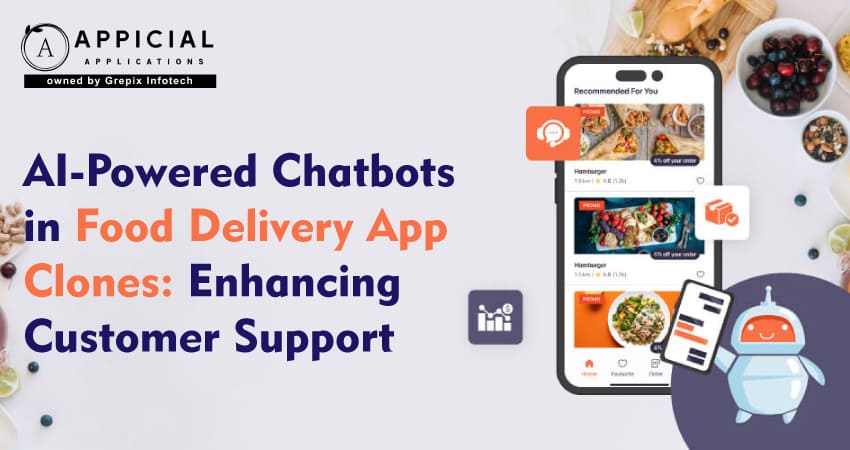
AI-Powered Chatbots in Food Delivery App Clones: Enhancing Customer Support
Picture this. It’s a Friday night. You’re starving, scrolling through your favorite food delivery app.
You place the order, and boom something goes wrong. Missing item, wrong delivery address, maybe even a glitchy app moment. You try to reach support, but the response time? Let’s just say your stomach is growling louder than the hold music.
Enter AI chatbot food app solutions. These aren’t your clunky “Press 1 for...” customer service bots. They’re faster, smarter, and believe it or not actually helpful. In fact, they're quietly changing the way food delivery apps interact with users. Especially when it comes to food app clone chatbot integration, where businesses are building off existing models to offer seamless, on-demand support.
Let’s break down how it all works, why it matters, and what real companies are doing with this tech.
AI isn't just about robots or sci-fi anymore. It's right here in our food delivery apps, shaping how we chat, order, and solve problems. In this blog, we’ll unpack the real-world benefits of integrating AI chatbot food app solutions into food app clone chatbot integration setups. You’ll see how automated customer support not only lightens the load on support teams but also creates smoother, faster customer experiences. Plus, we’ll look at real examples and even share tips on how to roll this out in your own app. Let’s dig in.
Role of AI Chatbots in Food Delivery App Clones
So what exactly do these bots do in a food app? Great question.
In simple terms, AI chatbot food app systems act like digital customer service reps only they’re lightning fast, don’t sleep, and don’t need coffee breaks. They use natural language processing (NLP) to understand user queries and provide instant responses.
But in food app clone chatbot integration, things go a step further.
Clone apps are basically replicas of successful food delivery platforms like Uber Eats or DoorDash. Businesses use them to launch similar services quickly and affordably. Integrating AI chatbot food app tech into these clones means startups and entrepreneurs can offer top-tier customer support without the cost of a huge support team.
These chatbots handle a range of tasks, including:
- Order status updates (“Where’s my food?”)
- Payment troubleshooting
- Refund requests
- Restaurant inquiries
- Delivery tracking
- Promo code issues
- Menu browsing help
And here’s the kicker they’re available 24/7. Rain or shine.
What are the Potential Benefits for Customer Service?
The integration of automated customer support into a food app clone chatbot doesn’t just add bells and whistles. It transforms how your app communicates, solves problems, and builds customer loyalty.
1. Speed
Let’s face it no one enjoys playing the waiting game when they’re hungry. No customer wants their query to be solved tomorrow. That’s where AI chatbot food app systems come into play!
These bots respond instantly—no queues, no delays, no “we’ll get back to you in 24 hours.” They resolve the most common issues in real-time, turning potentially frustrating experiences into smooth interactions. Speed isn’t just about satisfaction—it’s about survival in the fiercely competitive food delivery space. Customers who get help quickly are far more likely to stick around.
2 Reduced Human Error
Even the best customer support agent can slip up now and then. Wrong refund amounts, misinterpreted queries, or just a bad day it happens. But automated customer support bots? They operate based on structured logic and well-defined flows. They don’t get tired. They don’t guess. They don’t forget.
That consistency builds trust. When users know they’ll get the right answer every time, they’re more likely to turn to your app again. Over time, this reduces friction and increases loyalty. Plus, it lightens the burden on your human team they’ll thank you for it.
3 Cost Efficiency
Hiring, training, and retaining a full customer support team is expensive. Multiply that across multiple time zones, and the bills add up fast. Not to mention the cost of handling seasonal spikes, like rainy evenings or national holidays when everyone’s ordering in.
By deploying a AI chatbot food app, you dramatically reduce these operational costs. A single chatbot can handle thousands of conversations simultaneously—without breaks, without overtime, and without burnout. That means you can deliver round-the-clock service while keeping your budget in check.
For startups and growing businesses using food app clone chatbot integration, this kind of lean efficiency can be a game changer.
4 Scalability
Your business is booming. Great! But can your support team keep up?
Scaling traditional customer service means more hires, more desks, more management overhead. But chatbots? They scale with a few clicks. Whether you’re getting 100 queries a day or 10,000, a well-designed automated customer support system handles the load effortlessly.
And here’s the kicker it doesn’t just maintain service quality at scale. It often improves it. More queries = more data = smarter bots. The larger your operation grows, the more intelligent your chatbot becomes. That’s the kind of growth every business dreams about.
5 Multilingual Support
Today’s food delivery customers come from all walks of life, often speaking different languages. If your app only speaks English (or a single local language), you’re leaving a lot of people out and that means lost revenue.
Luckily, most contemporary AI chatbot food app platforms have multilingual support. Whatever language your users may be using—Hindi, Spanish, Mandarin, Arabic, or Swahili the bot can identify and reply in the correct language, frequently translating in real time according to user choice.
It's not just about accessibility. It's about bringing every customer to the table, regardless of where they're from. And in a world that's become increasingly globalized, that's more important than ever.
Implementation Strategies
Alright, so you're convinced about the concept. But how do you actually execute it?
1 Pick the Right Chatbot Platform
There are a ton of options—Dialogflow, IBM Watson, Microsoft Bot Framework, and many others. Choose one that integrates smoothly with your tech stack and understands food delivery workflows.
Pro tip: Go with a platform that supports NLP and machine learning so the bot gets smarter over time.
2 Prioritize Common Use Cases
Start small. Focus on the 5–10 most common queries. Build scripts for those and optimize based on real user feedback.
Example:
- “Track my order”
- “I want a refund.”
- “My food is cold.”
You don’t have to solve every problem right away. Nail the basics first.
3 Seamless Handover to Human Agents
This is huge. If a bot can’t resolve an issue, it should immediately route the user to a human agent. And that agent should have context. Nothing’s worse than repeating yourself five times.
4 UI/UX Integration
Make the chatbot feel like part of your app. Give it a name. Use friendly language. Add emojis, quick-reply buttons, even voice support if it fits your brand.
5 Use Data to Improve
Monitor which queries bots can’t handle. Add those to the training set. Every conversation is a learning opportunity. Within weeks, you’ll see major improvements.
Also Read: Personalized Recommendations in Food Delivery App Clones Using Machine Learning
Case Studies: Real Brands Doing It Right
1 Swiggy (India)
Swiggy’s chatbot helps users track their food in real-time and handles issues like missing items or delayed orders. Their use of AI chatbot food app technology has significantly reduced ticket resolution time.
2 Domino’s (Global)
Domino’s took a bold approach by letting users order pizza directly through their chatbot. That’s next-level food app clone chatbot integration, blending customer service with order placement.
3 Postmates (USA)
Before being acquired by Uber, Postmates used a bot named "PostmateBot" for automated customer support. It handled basic FAQs and could escalate issues to human agents when needed.
4 Local Food Startups Using Clones
Smaller food delivery startups often use food app clone chatbot integration to punch above their weight. With smart bots, even a three-person team can offer support that feels enterprise-grade.
Wrapping It Up: Chatbots Aren’t Just Nice to-Have Anymore
Here’s the truth: if you’re running a food delivery business or thinking of launching one you can’t afford to ignore AI chatbot food app solutions.
Your customers expect quick answers. They don’t want to email support or wait in queues. They want their sushi, their shawarma, their samosas now and they want help now too.
Integrating automated customer support into your food app clone chatbot integration isn’t just smart. It’s essential. And it gives you a serious competitive edge.
Why Appicial Applications Is Your Go-To Partner?
If you’re thinking about building or scaling a food delivery app, don’t start from scratch. Appicial Applications specializes in food app clone chatbot integration that’s both seamless and scalable. Whether you need a complete UberEats style platform or just the bot integration, they’ve got your back.
Here’s why we recommend them:
- Proven expertise in on-demand app clones
- Customizable chatbot modules tailored for food delivery
- Affordable pricing for startups and enterprises
- Ongoing support and updates
Author's Bio

Vinay Jain is the Founder at Grepix Infotech and brings over 12 years of entrepreneurial experience. His focus revolves around software & business development and customer satisfaction.
Back to blog list




